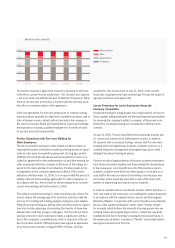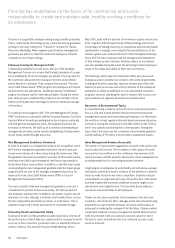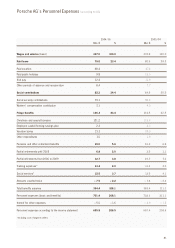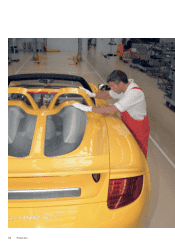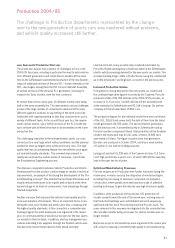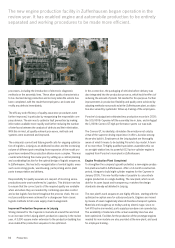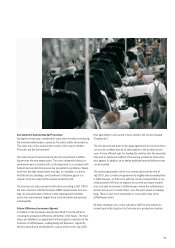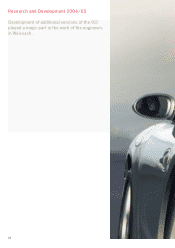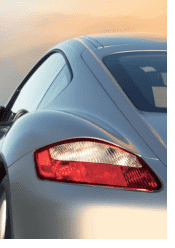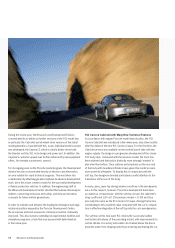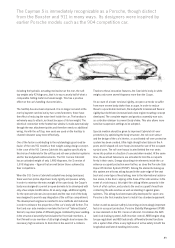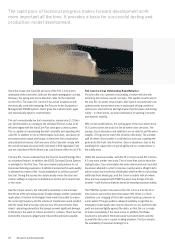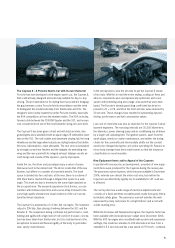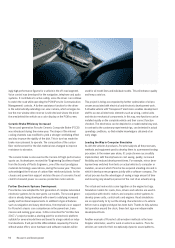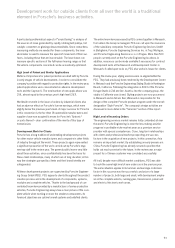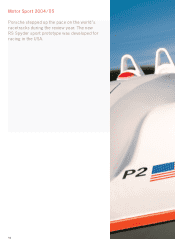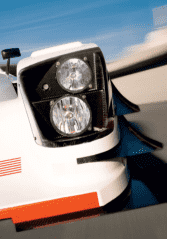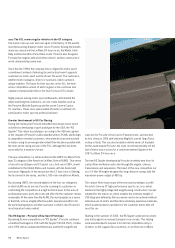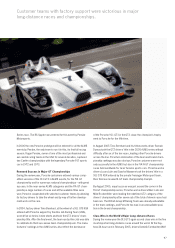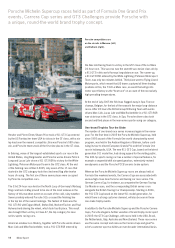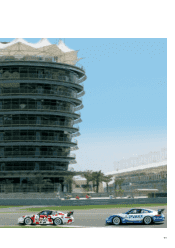Porsche 2004 Annual Report Download - page 93
Download and view the complete annual report
Please find page 93 of the 2004 Porsche annual report below. You can navigate through the pages in the report by either clicking on the pages listed below, or by using the keyword search tool below to find specific information within the annual report.
89
The Cayman S is immediately recognizable as a Porsche, though distinct
from the Boxster and 911 in many ways. Its designers were inspired by
earlier Porsche models such as the 904 competition car.
Including the hydraulic actuating mechanism at the rear, the soft
top weighs only 42 kilograms, that is to say scarcely half of what a
comparable folding metal roof would weigh. This has a positive
effect on the car’s handling characteristics.
The hardtop has also been improved. It is no longer secured at the
rear by bayonet catches but by two screw fasteners; these have
the effect of reducing the noise level inside the car. The hardtop is
extremely easy to attach, not least because of its low weight. The
electrical connection to the heated rear window is made automatically
through the rear attachment points and therefore needs no additional
wiring. As with the soft top, new seals are used on the hardtop to
channel rainwater away more effectively.
One of the factors contributing to the outstandingly good road be-
havior of the new 911 models is their weight-saving design concept.
In the case of the 911 Carrera Cabriolet this applies specifically to
the choice of materials for the soft top and roll-over protection systems
and for the bodyshell reinforcements. The 911 Carrera Cabriolet
has an unloaded weight of only 1,480 kilograms, the S version of
1,505 kilograms – figures that are well below those achieved by
their competitors.
When the 911 Carrera Cabriolet bodyshell was being developed,
there were two prime objectives: body rigidity and passive safety.
In order to minimize the extra weight of the open body, the Coupe’s
body was designed to permit an open derivate to be developed with
only a few simple modifications. At an early stage, additional rigidity
for the open version was incorporated and the rear end of the body
was designed to permit easy integration of the soft top compartment.
The development engineers resorted to new methods and materials
in order to enhance the properties of the car’s body still further. The
front and rear side members now take the form of “tailored blanks”,
that is to say steel plates of different gages combined by laser welding.
In the structural assembly that includes the front side members, a
front firewall cross-member of ultra-high strength steel ensures the
necessary high resistance to distortion in the event of a collision.
Thanks to these innovative features, the Cabriolet’s body-in-white
weighs only some seven kilograms more than the Coupe.
On account of a lower torsional rigidity, an open car tends to suffer
from more severe body shake than a coupe. In order to reduce
these to a practicable minimum, the bodyshell’s torsional and flexural
rigidity have both been increased and a new engine mounting concept
developed. The complete engine and gearbox assembly now acts
as a vibration damper to prevent body shake. This also allows more
sensitive suspension settings to be adopted.
Special mention should be given to improved Cabriolet roll-over
protection; by optimizing the body structure, the roll-over sensor
and the design of the car’s interior, a coordinated roll-over protection
system has been created. Ultra-high strength steel tubes in the A-
posts and U-shaped roll-over hoops increase the size of the occupant
survival zone. The roll-over hoops located behind the rear seats
move into position in a fraction of a second when needed. At the same
time, the seat belt tensioners are activated to hold the occupants
firmly in their seats. Energy-absorbing trim elements inside the car
enhance occupant protection even further, as does the Porsche Side
Impact Protection System (POSIP). Among the elements making up
this system are a thorax airbag housed in the outer edge of the seat
back and a new type of head airbag, new to the international automo-
tive scene, in the door capping at the base of the side window. In the
event of a side impact, this eight-liter airbag inflates upwards in the
form of a flat cushion, and protects the seat occupant’s head from
contacting the side window as well as shielding it against glass
splinters. This airbag has been especially developed for open cars;
Porsche is the first manufacturer to install it as standard equipment.
Active as well as passive safety is becoming an increasingly important
factor in occupant protection. Porsche Stability Management (PSM)
is now standard on the 911 Carrera Cabriolet. It combines the ABS
(anti-lock braking system), ASR (traction control), MSR (engine drag
torque regulation) and ABD (automatic differential brake) functions
into a system that offers a very high level of active safety in both the
longitudinal and lateral handling limit zones.


